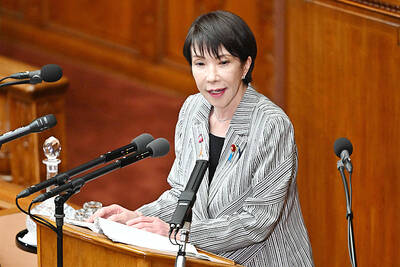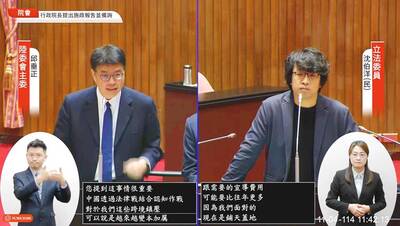The Diaoyutai Islands (釣魚台) are a territory of the Republic of China (ROC) “surreptitiously occupied” by Japan, the Ministry of Foreign Affairs said in a statement late on Friday night.
In the statement, issued in response to the release of 14 pro-China activists who were arrested by Japanese coast guard officers on Wednesday after they landed on the islands to assert Chinese sovereignty, the ministry used the phrase “surreptitiously occupied” to describe the Diaoyutais.
“Regarding the appearance of the ROC flag [in the protest staged by the pro-China activists] on the Diaoyutai Islands of our territory surreptitiously occupied by Japan, we thought it conformed to our government’s territory contention,” it said.
Asked to elaborate yesterday, MOFA spokesperson Steve Hsia (夏季昌) said it could be the first time that the ministry explained the origins of the disputes with Japan over sovereignty over the Diaoyutais in such a “straightforward” way.
“It was a factual description of history,” Hsia said.
According to Hsia, the Japanese government had planned to place national boundary markers on the Diaoyutai Islands as early as 1885, and on Jan. 14, 1895, it approved a policy that allowed Okinawa Prefecture to erect national markers.
Hsia said that the Japanese government had postponed taking action since 1885 because it knew that the Diaoyutai Islands had been discovered, named and used by the Chinese, as shown by various Japanese documents obtained by historians, including Shaw Han-yi (邵漢儀), son of retired government official Shaw Yu-ming (邵玉銘).
Japan erected its boundary marker on the Diaoyutai Islands in 1968, he said.
During the first Sino-Japanese War of 1894-1895, in January 1895, Japan annexed the Diaoyutais, the ministry said.
In April 1895, Japan and China signed the Treaty of Shimonoseki, which stipulated that China cedes the island of Taiwan to Japan, “together with all the islands appertaining or belonging to the said Island of Formosa [Taiwan],” it said.
In 1970, the US and Japan signed the Okinawa Reversion Treaty, which included the Diaoyutai Islands as part of Okinawa to be returned to Japanese rule.
Japan’s sovereignty claim over the territory was partly backed by the treaty, but the ministry disagreed.
“The treaty gives only administrative jurisdiction of the Diaoyutai Islands to Japan and has nothing to do with sovereignty,” Hsia said.
Since the 1970s, the Japanese government has claimed that “from 1885 on, surveys of the Senkaku Islands [the Japanese term for the Diaoyutais] have been repeatedly made by the Government of Japan through the agencies of Okinawa Prefecture,” Hsia said.
The Japanese government claimed that the islands had been uninhabited and showed no trace of having been under the control of the Qing Dynasty, the ministry said.
“The statement is historically inaccurate and can be refuted based on official Meiji documents from 1885 to 1895 stored in the various national archives of Japan,” it said.

‘SECRETS’: While saying China would not attack during his presidency, Donald Trump declined to say how Washington would respond if Beijing were to take military action US President Donald Trump said that China would not take military action against Taiwan while he is president, as the Chinese leaders “know the consequences.” Trump made the statement during an interview on CBS’ 60 Minutes program that aired on Sunday, a few days after his meeting with Chinese President Xi Jinping (習近平) in South Korea. “He [Xi] has openly said, and his people have openly said at meetings, ‘we would never do anything while President Trump is president,’ because they know the consequences,” Trump said in the interview. However, he repeatedly declined to say exactly how Washington would respond in

Japanese Prime Minister Sanae Takaichi said yesterday that China using armed force against Taiwan could constitute a "survival-threatening situation" for Japan, allowing the country to mobilize the Japanese armed forces under its security laws. Takaichi made the remarks during a parliamentary session yesterday while responding to a question about whether a "Taiwan contingency" involving a Chinese naval blockade would qualify as a "survival-threatening situation" for Japan, according to a report by Japan’s Asahi Shimbun. "If warships are used and other armed actions are involved, I believe this could constitute a survival- threatening

WARFARE: All sectors of society should recognize, unite, and collectively resist and condemn Beijing’s cross-border suppression, MAC Minister Chiu Chui-cheng said The number of Taiwanese detained because of legal affairs by Chinese authorities has tripled this year, as Beijing intensified its intimidation and division of Taiwanese by combining lawfare and cognitive warfare, the Mainland Affairs Council (MAC) said yesterday. MAC Minister Chiu Chui-cheng (邱垂正) made the statement in response to questions by Democratic Progressive Party (DPP) Legislator Puma Shen (沈柏洋) about the government’s response to counter Chinese public opinion warfare, lawfare and psychological warfare. Shen said he is also being investigated by China for promoting “Taiwanese independence.” He was referring to a report published on Tuesday last week by China’s state-run Xinhua news agency,

‘ADDITIONAL CONDITION’: Taiwan will work with like-minded countries to protect its right to participate in next year’s meeting, the foreign ministry said The US will “continue to press China for security arrangements and protocols that safeguard all participants when attending APEC meetings in China,” a US Department of State spokesperson said yesterday, after Beijing suggested that members must adhere to its “one China principle” to participate. “The United States insists on the full and equal participation of all APEC member economies — including Taiwan — consistent with APEC’s guidelines, rules and established practice, as affirmed by China in its offer to host in 2026,” the unnamed spokesperson said in response to media queries about China putting a “one China” principle condition on Taiwan’s